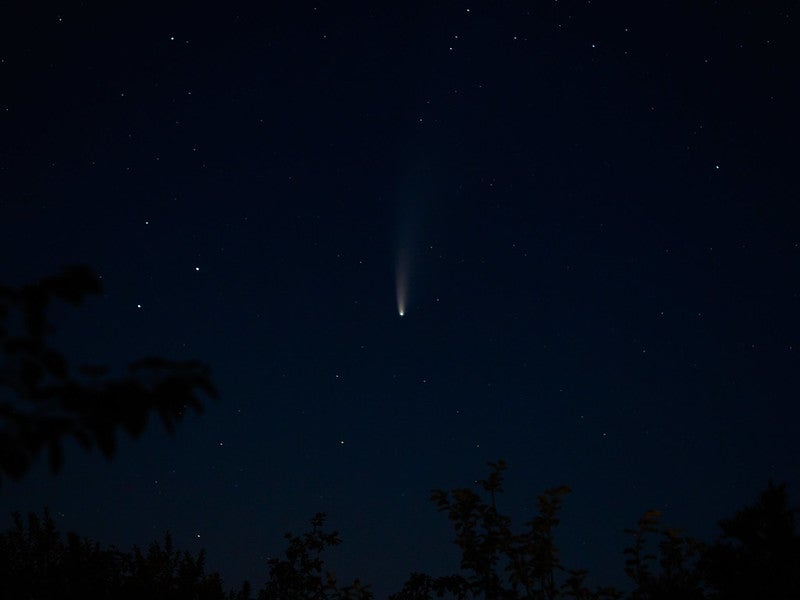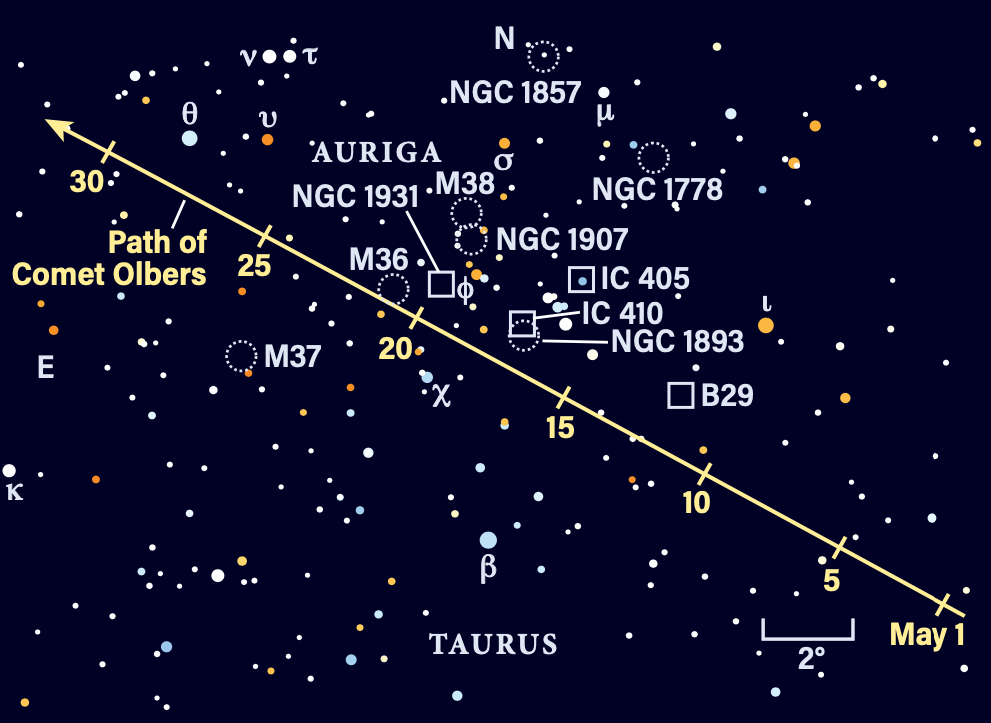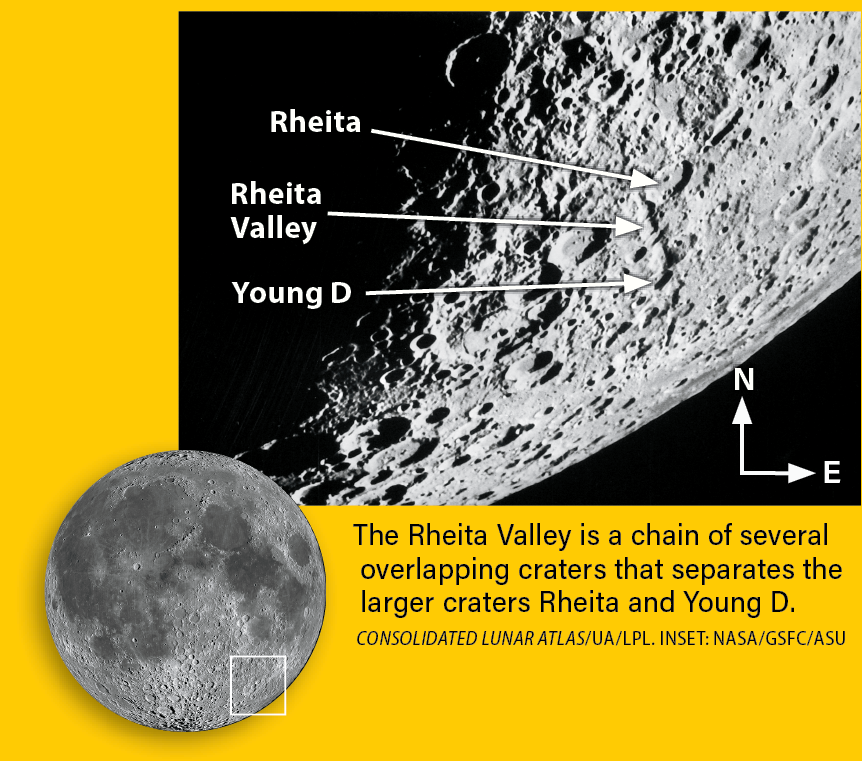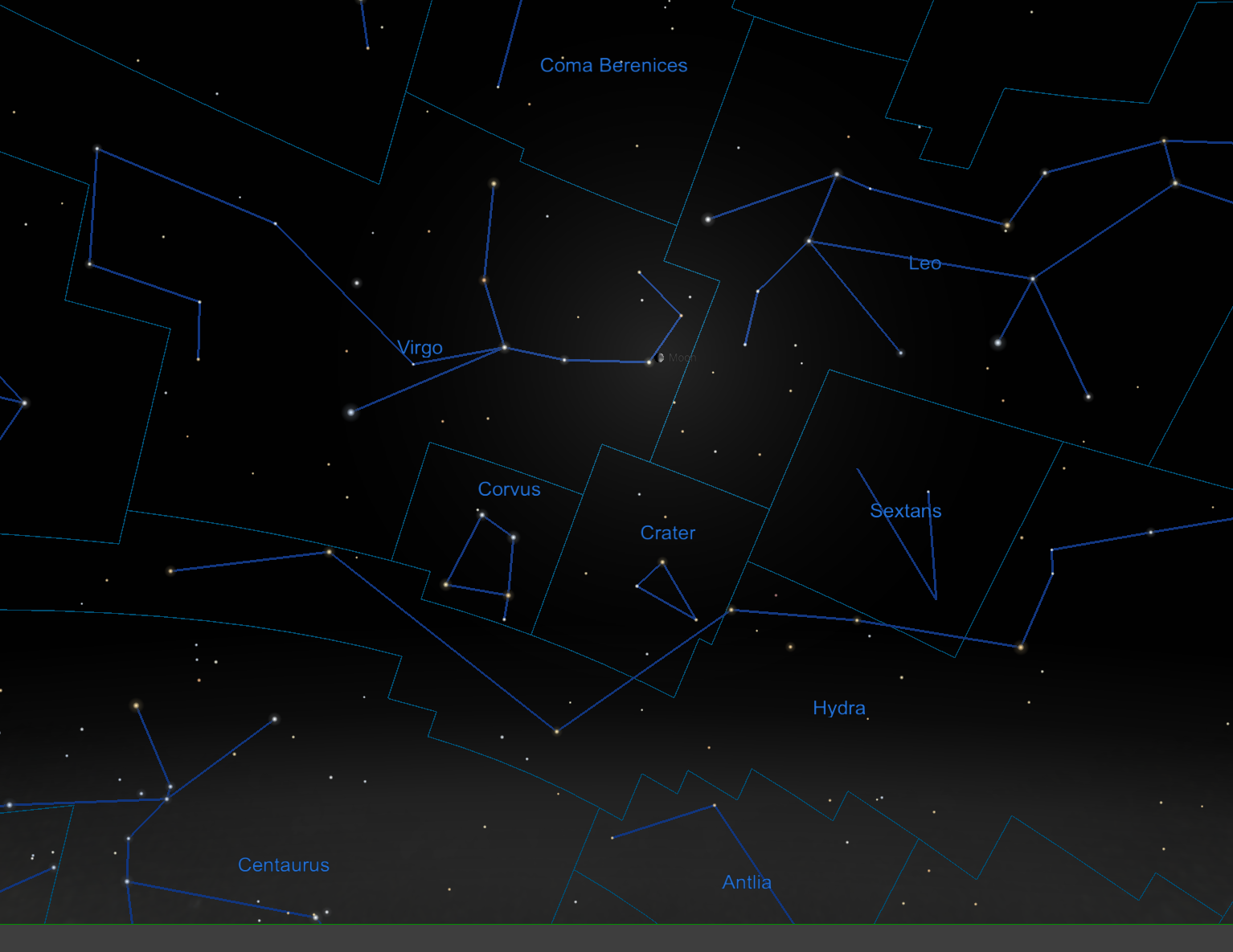
Friday, May 10
If you’ve got a good view of the northern, sky, try catching Comet C/2021 S3 (PanSTARRS) tonight as it passes near Cygnus the Swan’s brightest star, Deneb.
You’ll want to wait a few hours after sunset to give the region time to rise in the northeast. Then, find magnitude 1.3 Deneb and slide about 3.7° northwest to land on PanSTARRS, currently glowing at magnitude 11. This fuzzball is faint, so you’ll want a larger scope or to try for some long-exposure photographs to capture its fading glow. PanSTARRS passed perihelion, the closest point to the Sun in its orbit, on Valentine’s Day and is now on its way out of the inner solar system, hence its magnitude. Nonetheless, it’s visible all night, unlike tomorrow’s target, Comet 13P/Olbers, which doesn’t linger long after darkness falls.
In addition to the comet, Cygnus hosts a wealth of deep-sky objects, including the North America Nebula (NGC 7000) just over 3° east-southeast of Deneb. So named for its resemblance to the continent, this lovely emission nebula stretches 2° across at its widest and is said to be visible to the naked eye for those with excellent eyesight and excellent conditions. It will surely be a brighter target for your telescope to pick up even if you’re having trouble with the comet, so spend some time enjoying this region and the bright stars embedded within. The thin crescent Moon’s light shouldn’t interfere much, particularly as the evening wears on.
Just southwest of the North America Nebula, separated by a thin, dark swath of dust, lies the fainter and smaller Pelican Nebula (IC 5067/5070) as well.
Sunrise: 5:49 A.M.
Sunset: 8:04 P.M.
Moonrise: 7:22 A.M.
Moonset: 11:33 P.M.
Moon Phase: Waxing crescent (9%)
*Times for sunrise, sunset, moonrise, and moonset are given in local time from 40° N 90° W. The Moon’s illumination is given at 12 P.M. local time from the same location.

Saturday, May 11
Let’s try for some faster-paced cometary action: Comet 13P/Olbers is 15° high in the west an hour after sunset and will continue to sink even as the sky grows darker and better for observing it. Recently recorded at magnitude 8.6, Olbers should continue brightening and climbing — albeit just a little — in the sky night by night as summer approaches.
Now in Auriga the Charioteer, Olbers is approaching perihelion (unlike PanSTARRS, which we viewed last night). Comet Olbers will swing closest to the Sun at the end of June, when it’s expected to reach magnitude 7. You can find Olbers tonight by first locating Elnath, also cataloged as Beta (β) Tauri, which marks the tip of Taurus’ righthand horn as the Bull is setting. Olbers lies about 4.5° west-northwest of this star, roughly halfway between magnitude 1.7 Beta Tau and fainter, magnitude 2.7 Iota (ι) Aurigae. If you’re able to follow the region as the sky grows dark, you may note that Olbers lies just south of the dark nebula Barnard 29 tonight. This round, dusty cloud looks almost like a small, dark hole punched out of the stars! It’s best viewed with larger scopes, so push your aperture to 10 inches or more if you can.
And if you’re looking for a gorgeous naked-eye sight, you’re in luck: A beautiful waxing crescent Moon lies above the scene, located within Gemini the Twins. Luna hangs just below that constellation’s alpha star, magnitude 1.6 Castor. Can you see any earthshine illuminating the Moon’s still-darkened western regions? This phenomenon occurs when sunlight bounces off the daytime hemisphere of Earth and onto the Moon, including the portions of our satellite that sit in shadow.
Sunrise: 5:48 A.M.
Sunset: 8:05 P.M.
Moonrise: 8:19 A.M.
Moonset: — P.M.
Moon Phase: Waxing crescent (16%)

Sunday, May 12
Let’s return to the Moon tonight, still hanging out in the west with Gemini an hour after sunset.
Now the Moon has moved past Castor and stands just left of Pollux, the Twins’ beta star. Our satellite is still waxing toward First Quarter and is nearly 30 percent lit as sunrise slowly breaks across its rugged surface from east to west. The Moon is rising later and later each day as well, so that by the time it reaches Full, it will rise (and set) directly opposite the Sun, appearing over the eastern horizon around sunset.
Use your telescope to home in on the southwest limb to look for the Rheita Valley, an elongated chain of overlapping craters just below the crater Rheita, which is relatively easy to pick out to the valley’s northeast with its conspicuous central peak.
The valley itself is a walk backward through time, as each crater was formed by successive impacts that wiped out a portion of the one that came before it. They are associated with the larger overall impact that formed Mare Nectaris, the large, dark, lava-filled impact basin to their north. If you’re able to come back and observe this region later in the month, say on the 24th and 25th, you’ll see it in reversed lighting as the Sun sets in the lunar west. This lighting can help point the eye back toward Mare Nectaris for a clearer picture of the association between it and the valley’s formation.
Sunrise: 5:47 A.M.
Sunset: 8:06 P.M.
Moonrise: 9:22 A.M.
Moonset: 12:27 A.M.
Moon Phase: Waxing crescent (24%)
Monday, May 13
Uranus is in conjunction with the Sun at 5 A.M. EDT, rendering it invisible. So, let’s hunt down the solar system’s other ice giant, Neptune, which hangs in the early-morning sky.
Because Neptune is so distant, it glows at only magnitude 7.8, too faint for the naked eye to pick up — but well within the reach of binoculars or any small telescope. The faraway world is located about halfway between Mars and Saturn, which are both visible to the naked eye in the eastern sky an hour before sunrise. Mars lies closer to the horizon, about 8° high at that time and glowing at magnitude 1.1. Saturn, to the Red Planet’s upper right, is 17° high and just a tiny bit brighter at magnitude 1. Both will likely appear the same brightness to your eye, though Mars may look orange or red, while Saturn should seem white or even yellowish.
Draw a line between the two planets in your mind’s eye and focus your search halfway along it, just below the Circlet of Pisces (while those stars are still visible in the sky). Neptune lies 10.5° west of Mars and about 11.5° east of Saturn — so not exactly halfway between them, but close! Through your optics, the planet will appear as a dim, “flat” star; its disk is just 2″ wide, possibly discernible if you’ve got good seeing and a sharp eye. It may appear gray or subtly blue as well.
Sunrise: 5:46 A.M.
Sunset: 8:07 P.M.
Moonrise: 10:28 A.M.
Moonset: 1:11 A.M.
Moon Phase: Waxing crescent (33%)
Tuesday, May 14
Let’s return to the predawn sky this morning, but a bit later — step outside just 30 minutes before sunrise this morning to catch the solar system’s innermost planet, Mercury, which has been brightening day by day. The planet reached its greatest western elongation just last week, when it stood 26° from the Sun.
This morning, you’ll find the tiny world some 4° high half an hour before sunrise — but it should be easy to spot at magnitude 0.3. Mercury is now in far eastern Pisces and, day by day, will appear to travel almost parallel to the horizon without getting higher over time. It will move leftward through the sky, skimming through a tiny portion of Cetus before entering Aries the Ram later this month, brightening all the while. By May’s end, Mercury will reach magnitude –0.8 and passes close to Uranus in the pre-dawn sky as the ice giant slowly comes out of the Sun’s glare.
If you’re willing to get up a bit earlier, some 40 to 50 minutes before sunrise, the brightest stars are still sprinkled throughout the sky as Mercury is just clearing the horizon. Look above Mars for the Great Square of Pegasus, bounded by Alpheratz, Scheat, Markab, and Algenib. Above the Winged Horse is Cygnus the Swan, with its tail star Deneb still glowing. And in the northeast, Mirfak and Algol in Perseus may still be visible before the sky grows too bright.
Sunrise: 5:45 A.M.
Sunset: 8:08 P.M.
Moonrise: 11:33 A.M.
Moonset: 1:46 A.M.
Moon Phase: Waxing crescent (43%)
Wednesday, May 15
First Quarter Moon occurs at 7:48 A.M. EDT. By the time evening rolls around, you can catch the Moon still riding high in the southwest with Leo, sitting near the Lion’s bright alpha star, magnitude 1.4 Regulus.
Trailing behind Leo is Virgo, a large constellation anchored by the bright star Spica (magnitude 1). The Maiden is home to the eponymous Virgo cluster of galaxies, which includes the massive elliptical galaxy M87, whose central supermassive black hole was the first ever imaged.
To Virgo’s upper left is Boötes the Herdsman, well known for its brightest star, magnitude –0.1 Arcturus. Boötes also contains the 9th-magnitude globular cluster NGC 5466, which was first discovered in the late 1700s by the prolific astronomer William Herschel. Spanning about 11′, you’ll find this ancient group of stars just over 9.5° north-northwest of Arcturus. It will stand out better the later it gets and the darker the sky grows as evening progresses.
Sunrise: 5:44 A.M.
Sunset: 8:09 P.M.
Moonrise: 12:36 P.M.
Moonset: 2:14 A.M.
Moon Phase: Waxing gibbous (52%)
Thursday, May 16
The Moon passes 1.1° north of asteroid 3 Juno at 9 A.M. EDT. By evening, the two are 6° apart, with Juno now west of our satellite. Even farther west of the Moon now is Regulus and the Sickle asterism it anchors. The Sickle is often likened to a backwards question mark and outlines the regal head of Leo in the sky.
Back to Juno: The third asteroid ever discovered glows faintly at 10th magnitude from a distance of some 231 million miles (372 million kilometers) from Earth. You can use the star Rho (ρ) Leonis to help you find it with binoculars or a small telescope — Juno sits just 2.5° northeast of this 4th-magnitude star.
Juno is one of the largest and most massive asteroids in the main belt, containing roughly 1 percent of all the mass in the belt. The largest body in the main belt, dwarf planet 1 Ceres, stands stationary in the constellation Sagittarius tonight at 7 P.M. EDT. It’s not visible above the horizon at this time, however, so we’ll catch up with it and the Archer early next week.
Sunrise: 5:44 A.M.
Sunset: 8:10 P.M.
Moonrise: 1:38 P.M.
Moonset: 2:37 A.M.
Moon Phase: Waxing gibbous (61%)

Friday, May 17
The Moon reaches apogee, the farthest point from Earth in its orbit, at 2:59 P.M. EDT. At that time, our satellite will be 251,432 miles (404,641 km) away.
By evening, Luna has moved from Leo into Virgo. After sunset, it sits close to the Maiden’s magnitude 3.6 beta star, Zavijava. And for observers in much of the U.S. and Canada, the Moon will slide in front of Zavijava in an occultation.
The timing and duration of the event depend heavily on your location. Those in Albany, New York, for example, will see Zavijava disappear at 1:29 A.M. EDT early on May 18 and reappear just over an hour later, at 2:33 A.M. EDT on the 18th. From Denver, Colorado, Zavijava disappears at 11:16 P.M. MDT on the 17th, reappearing again about an hour later, at 12:17 A.M. MDT on the 18th. And from Las Vegas, Nevada, the star only briefly disappears behind our Moon, starting at 10:36 P.M. PDT on the 17th and ending 14 minutes later, at 10:50 P.M. PDT.
You can get a map of all locations where the occultation will be visible, as well as the times (in Universal Time) of select cities, on the International Occultation Timing Association’s webpage for the event.
Sunrise: 5:43 A.M.
Sunset: 8:11 P.M.
Moonrise: 2:37 P.M.
Moonset: 2:58 A.M.
Moon Phase: Waxing gibbous (71%)

Sky This Week is brought to you in part by Celestron.









